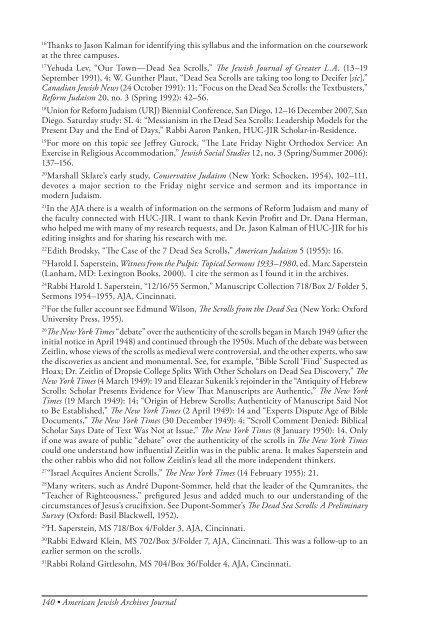The American Jewish Archives Journal, Volume LXI 2009, Number 1
The American Jewish Archives Journal, Volume LXI 2009, Number 1
The American Jewish Archives Journal, Volume LXI 2009, Number 1
You also want an ePaper? Increase the reach of your titles
YUMPU automatically turns print PDFs into web optimized ePapers that Google loves.
16 Thanks to Jason Kalman for identifying this syllabus and the information on the coursework<br />
at the three campuses.<br />
17 Yehuda Lev, “Our Town—Dead Sea Scrolls,” <strong>The</strong> <strong>Jewish</strong> <strong>Journal</strong> of Greater L.A. (13–19<br />
September 1991), 4; W. Gunther Plaut, “Dead Sea Scrolls are taking too long to Decifer [sic],”<br />
Canadian <strong>Jewish</strong> News (24 October 1991): 11; “Focus on the Dead Sea Scrolls: the Textbusters,”<br />
Reform Judaism 20, no. 3 (Spring 1992): 42–56.<br />
18 Union for Reform Judaism (URJ) Biennial Conference, San Diego, 12–16 December 2007, San<br />
Diego. Saturday study: SL 4: “Messianism in the Dead Sea Scrolls: Leadership Models for the<br />
Present Day and the End of Days,” Rabbi Aaron Panken, HUC-JIR Scholar-in-Residence.<br />
19 For more on this topic see Jeffrey Gurock, “<strong>The</strong> Late Friday Night Orthodox Service: An<br />
Exercise in Religious Accommodation,” <strong>Jewish</strong> Social Studies 12, no. 3 (Spring/Summer 2006):<br />
137–156.<br />
20 Marshall Sklare’s early study, Conservative Judaism (New York: Schocken, 1954), 102–111,<br />
devotes a major section to the Friday night service and sermon and its importance in<br />
modern Judaism.<br />
21 In the AJA there is a wealth of information on the sermons of Reform Judaism and many of<br />
the faculty connected with HUC-JIR. I want to thank Kevin Profitt and Dr. Dana Herman,<br />
who helped me with many of my research requests, and Dr. Jason Kalman of HUC-JIR for his<br />
editing insights and for sharing his research with me.<br />
22 Edith Brodsky, “<strong>The</strong> Case of the 7 Dead Sea Scrolls,” <strong>American</strong> Judaism 5 (1955): 16.<br />
23 Harold I. Saperstein, Witness from the Pulpit: Topical Sermons 1933–1980, ed. Marc Saperstein<br />
(Lanham, MD: Lexington Books, 2000). I cite the sermon as I found it in the archives.<br />
24 Rabbi Harold I. Saperstein, “12/16/55 Sermon,” Manuscript Collection 718/Box 2/ Folder 5,<br />
Sermons 1954–1955, AJA, Cincinnati.<br />
25 For the fuller account see Edmund Wilson, <strong>The</strong> Scrolls from the Dead Sea (New York: Oxford<br />
University Press, 1955).<br />
26 <strong>The</strong> New York Times “debate” over the authenticity of the scrolls began in March 1949 (after the<br />
initial notice in April 1948) and continued through the 1950s. Much of the debate was between<br />
Zeitlin, whose views of the scrolls as medieval were controversial, and the other experts, who saw<br />
the discoveries as ancient and monumental. See, for example, “Bible Scroll ‘Find’ Suspected as<br />
Hoax; Dr. Zeitlin of Dropsie College Splits With Other Scholars on Dead Sea Discovery,” <strong>The</strong><br />
New York Times (4 March 1949): 19 and Eleazar Sukenik’s rejoinder in the “Antiquity of Hebrew<br />
Scrolls: Scholar Presents Evidence for View That Manuscripts are Authentic,” <strong>The</strong> New York<br />
Times (19 March 1949): 14; “Origin of Hebrew Scrolls; Authenticity of Manuscript Said Not<br />
to Be Established,” <strong>The</strong> New York Times (2 April 1949): 14 and “Experts Dispute Age of Bible<br />
Documents,” <strong>The</strong> New York Times (30 December 1949): 4; “Scroll Comment Denied: Biblical<br />
Scholar Says Date of Text Was Not at Issue,” <strong>The</strong> New York Times (8 January 1950): 14. Only<br />
if one was aware of public “debate” over the authenticity of the scrolls in <strong>The</strong> New York Times<br />
could one understand how influential Zeitlin was in the public arena. It makes Saperstein and<br />
the other rabbis who did not follow Zeitlin’s lead all the more independent thinkers.<br />
27 “Israel Acquires Ancient Scrolls,” <strong>The</strong> New York Times (14 February 1955): 21.<br />
28 Many writers, such as André Dupont-Sommer, held that the leader of the Qumranites, the<br />
“Teacher of Righteousness,” prefigured Jesus and added much to our understanding of the<br />
circumstances of Jesus’s crucifixion. See Dupont-Sommer’s <strong>The</strong> Dead Sea Scrolls: A Preliminary<br />
Survey (Oxford: Basil Blackwell, 1952).<br />
29 H. Saperstein, MS 718/Box 4/Folder 3, AJA, Cincinnati.<br />
30 Rabbi Edward Klein, MS 702/Box 3/Folder 7, AJA, Cincinnati. This was a follow-up to an<br />
earlier sermon on the scrolls.<br />
31 Rabbi Roland Gittlesohn, MS 704/Box 36/Folder 4, AJA, Cincinnati.<br />
140 • <strong>American</strong> <strong>Jewish</strong> <strong>Archives</strong> <strong>Journal</strong>

















